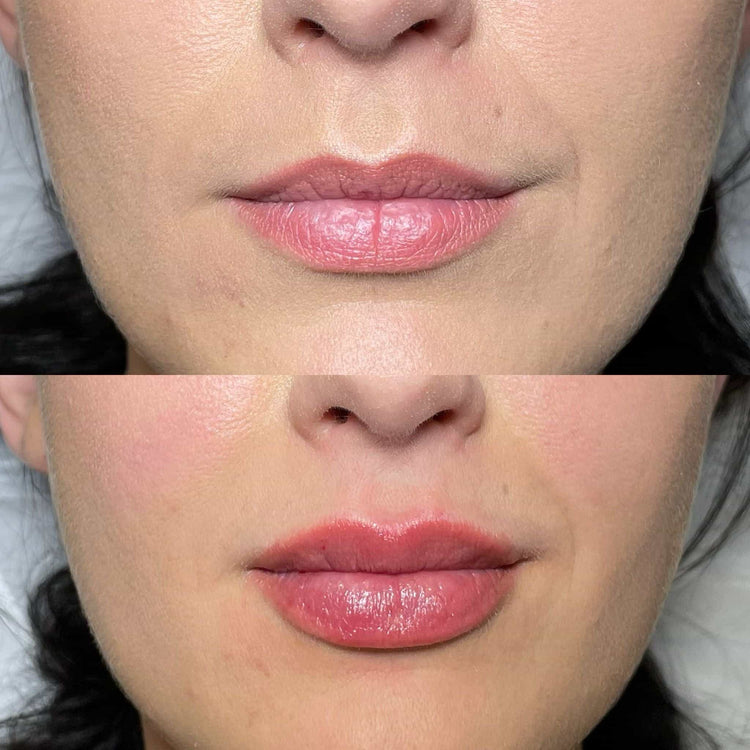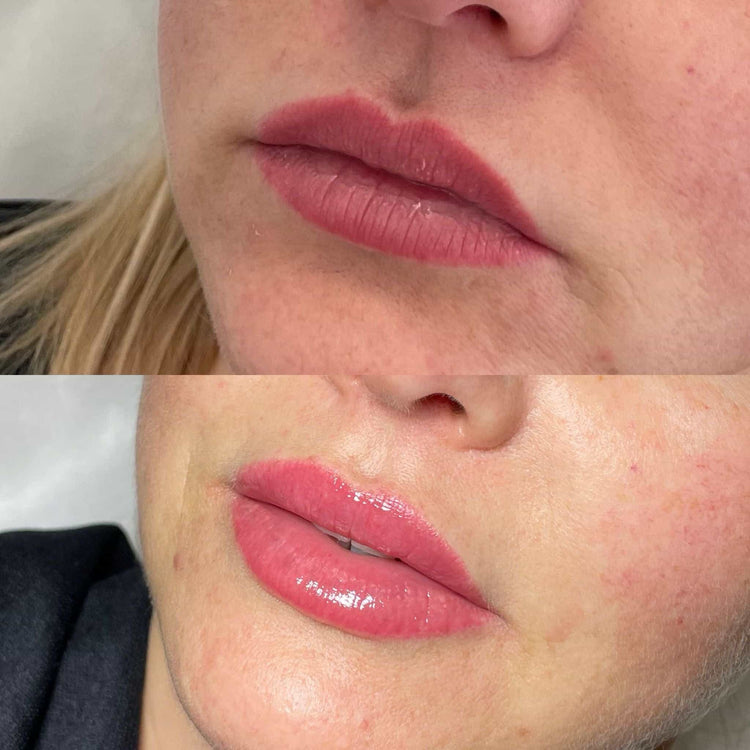Are Lip Fillers Painful? What UK Clients Should Know
May 1, 2025
The Procedure
Considering lip fillers to enhance your pout but concerned about the pain involved? You’re not alone. Many potential clients worry about discomfort during the procedure. This article delves into the realities of lip filler injections in the UK, addressing the pain levels and offering insights to help you make an informed decision.
Types of Fillers
The Procedure commonly involves injecting hyaluronic acid-based fillers into specific areas of the lips to add volume, shape, and definition. During the procedure, a topical numbing cream is applied to minimize discomfort.
There are various types of fillers available, with hyaluronic acid being the most popular choice for lip enhancement in the UK. Hyaluronic acid is a naturally occurring substance in the body that helps to retain moisture and provide plumpness to the skin. Different brands and formulations of hyaluronic acid fillers have varying degrees of thickness and viscosity, allowing practitioners to tailor the treatment to individual needs.
Needle Size and Injection Technique
The size of the needle used for lip filler injections is typically quite fine, ranging from 27 gauge to 30 gauge. This small diameter helps to minimize discomfort during insertion.
Injection technique plays a crucial role in minimizing pain. Experienced practitioners employ precise and gentle techniques to deliver the filler effectively while minimizing any potential discomfort.
Local Anesthesia
Local anesthesia is often used during lip filler procedures to ensure patient comfort.
Topical anesthetics, which are creams or gels applied to the skin prior to injection, numb the area and reduce initial discomfort.
Some practitioners may also use a local anesthetic solution injected superficially around the lips, providing deeper and more prolonged numbing.
Pain Perception
Pain perception is subjective and varies from person to person. Factors such as individual pain tolerance, anxiety levels, and previous experiences with injections can influence the level of discomfort experienced during lip filler procedures.
Individual Pain Tolerance
Individual pain tolerance plays a significant role in how people perceive discomfort during procedures like lip fillers. Some individuals may experience only mild pinching or stinging sensations, while others might feel more intense pain.
Several factors contribute to individual variations in pain tolerance, including genetics, psychological factors, and previous experiences with medical procedures.
Area of Treatment
Understanding your own pain threshold is crucial before undergoing any procedure involving injections. If you have a low pain tolerance or are particularly anxious about needles, discuss this openly with your chosen practitioner. They can advise on strategies to minimize discomfort during the treatment.
While most people find lip fillers to be relatively tolerable, it’s important to remember that some level of discomfort is generally expected.
By thoroughly researching potential practitioners, asking questions about their experience and techniques, and understanding your own pain tolerance, you can make an informed decision and minimize any anxiety surrounding the procedure.
Filler Type and Formulation
Considering lip fillers to enhance your pout but concerned about the pain involved? You’re not alone. Many potential clients worry about discomfort during the procedure. This article delves into the realities of lip filler injections in the UK, addressing the pain levels and offering insights to help you make an informed decision.
The Procedure commonly involves injecting hyaluronic acid-based fillers into specific areas of the lips to add volume, shape, and definition. During the procedure, a topical numbing cream is applied to minimize discomfort.
There are various types of fillers available, with hyaluronic acid being the most popular choice for lip enhancement in the UK. Hyaluronic acid is a naturally occurring substance in the body that helps to retain moisture and provide plumpness to the skin. Different brands and formulations of hyaluronic acid fillers have varying degrees of thickness and viscosity, allowing practitioners to tailor the treatment to individual needs.
The size of the needle used for lip filler injections is typically quite fine, ranging from 27 gauge to 30 gauge. This small diameter helps to minimize discomfort during insertion.
Injection technique plays a crucial role in minimizing pain. Experienced practitioners employ precise and gentle techniques to deliver the filler effectively while minimizing any potential discomfort.
Local anesthesia is often used during lip filler procedures to ensure patient comfort.
Topical anesthetics, which are creams or gels applied to the skin prior to injection, numb the area and reduce initial discomfort.
Some practitioners may also use a local anesthetic solution injected superficially around the lips, providing deeper and more prolonged numbing.

Pain perception is subjective and varies from person to person. Factors such as individual pain tolerance, anxiety levels, and previous experiences with injections can influence the level of discomfort experienced during lip filler procedures.
Individual pain tolerance plays a significant role in how people perceive discomfort during procedures like lip fillers. Some individuals may experience only mild pinching or stinging sensations, while others might feel more intense pain.
Several factors contribute to individual variations in pain tolerance, including genetics, psychological factors, and previous experiences with medical procedures.
Understanding your own pain threshold is crucial before undergoing any procedure involving injections. If you have a low pain tolerance or are particularly anxious about needles, discuss this openly with your chosen practitioner. They can advise on strategies to minimize discomfort during the treatment.
While most people find lip fillers to be relatively tolerable, it’s important to remember that some level of discomfort is generally expected.
By thoroughly researching potential practitioners, asking questions about their experience and techniques, and understanding your own pain tolerance, you can make an informed decision and minimize any anxiety surrounding the procedure.
Managing Discomfort
Considering lip fillers to enhance your pout but concerned about the pain involved? You’re not alone. Many potential clients worry about discomfort during the procedure. This article delves into the realities of lip filler injections in the UK, addressing the pain levels and offering insights to help you make an informed decision.
The Procedure commonly involves injecting hyaluronic acid-based fillers into specific areas of the lips to add volume, shape, and definition. During the procedure, a topical numbing cream is applied to minimize discomfort.
There are various types of fillers available, with hyaluronic acid being the most popular choice for lip enhancement in the UK. Hyaluronic acid is a naturally occurring substance in the body that helps to retain moisture and provide plumpness to the skin. Different brands and formulations of hyaluronic acid fillers have varying degrees of thickness and viscosity, allowing practitioners to tailor the treatment to individual needs.
The size of the needle used for lip filler injections is typically quite fine, ranging from 27 gauge to 30 gauge. This small diameter helps to minimize discomfort during insertion.
Injection technique plays a crucial role in minimizing pain. Experienced practitioners employ precise and gentle techniques to deliver the filler effectively while minimizing any potential discomfort.
Local anesthesia is often used during lip filler procedures to ensure patient comfort.
Topical anesthetics, which are creams or gels applied to the skin prior to injection, numb the area and reduce initial discomfort.
Some practitioners may also use a local anesthetic solution injected superficially around the lips, providing deeper and more prolonged numbing.
Pain perception is subjective and varies from person to person. Factors such as individual pain tolerance, anxiety levels, and previous experiences with injections can influence the level of discomfort experienced during lip filler procedures.
Individual pain tolerance plays a significant role in how people perceive discomfort during procedures like lip fillers. Some individuals may experience only mild pinching or stinging sensations, while others might feel more intense pain.
Several factors contribute to individual variations in pain tolerance, including genetics, psychological factors, and previous experiences with medical procedures.
Understanding your own pain threshold is crucial before undergoing any procedure involving injections. If you have a low pain tolerance or are particularly anxious about needles, discuss this openly with your chosen practitioner. They can advise on strategies to minimize discomfort during the treatment.
While most people find lip fillers to be relatively tolerable, it’s important to remember that some level of discomfort is generally expected.
By thoroughly researching potential practitioners, asking questions about their experience and techniques, and understanding your own pain tolerance, you can make an informed decision and minimize any anxiety surrounding the procedure.
Pre-Treatment Preparation
Managing discomfort is a priority for both practitioners and patients during lip filler procedures.
Several strategies are employed to ensure patient comfort throughout the process.
Topical anesthetic creams or gels applied to the lips prior to injection numb the area, reducing initial discomfort.
Practitioners may also use a local anesthetic solution injected superficially around the lips for deeper and longer-lasting numbing.
The size of the needle used in lip filler injections is typically quite fine, ranging from 27 gauge to 30 gauge. This smaller diameter minimizes discomfort during insertion.
Experienced practitioners employ precise and gentle injection techniques, further minimizing any potential pain.
Numbing Creams and Medications
Managing discomfort is a priority for both practitioners and patients during lip filler procedures.
Several strategies are employed to ensure patient comfort throughout the process.
Topical anesthetic creams or gels applied to the lips prior to injection numb the area, reducing initial discomfort.
Practitioners may also use a local anesthetic solution injected superficially around the lips for deeper and longer-lasting numbing.
The size of the needle used in lip filler injections is typically quite fine, ranging from 27 gauge to 30 gauge. This smaller diameter minimizes discomfort during insertion.
Experienced practitioners employ precise and gentle injection techniques, further minimizing any potential pain.
Post-Treatment Care
Managing discomfort is a priority for both practitioners and patients during lip filler procedures. Several strategies are employed to ensure patient comfort throughout the process.
Topical anesthetic creams or gels applied to the lips prior to injection numb the area, reducing initial discomfort.
Practitioners may also use a local anesthetic solution injected superficially around the lips for deeper and longer-lasting numbing.
The size of the needle used in lip filler injections is typically quite fine, ranging from 27 gauge to 30 gauge. This smaller diameter minimizes discomfort during insertion.
Experienced practitioners employ precise and gentle injection techniques, further minimizing any potential pain.
After the procedure, patients are advised on how to manage any residual discomfort or swelling.
It’s normal to experience some swelling, bruising, or redness at the injection site immediately after treatment. These side effects typically subside within a few days.
Cold compresses can be applied to reduce swelling and inflammation. Over-the-counter pain relievers, such as ibuprofen or paracetamol, may be used to manage any discomfort.
Avoiding strenuous activity and direct sun exposure for the first few days following treatment can also help minimize potential side effects and promote healing.
Patients should follow their practitioner’s post-treatment instructions carefully and attend any scheduled follow-up appointments.
Factors Affecting Pain Level
Many factors influence how much pain a person experiences during lip filler injections. Individual pain tolerance varies greatly, as does anxiety around needles. Previous experiences with injections can also play a role.
Experience of the Practitioner

The experience and skill of the practitioner are crucial in minimizing pain during lip filler procedures.
An experienced injector understands the anatomy of the lips and uses precise techniques to deliver the filler effectively while causing minimal discomfort. They also know how to manage patient anxiety and ensure a comfortable experience.
During consultations, potential clients should inquire about the practitioner’s experience with lip fillers and ask about their approach to pain management.
Clinic Environment
Various factors can influence the level of pain experienced during lip filler procedures.
Individual pain tolerance varies significantly from person to person. Some individuals may feel only mild pinching or stinging sensations, while others may experience more intense discomfort.
Anxiety levels and previous experiences with injections can also play a role in pain perception.
The size and type of needle used during the procedure can influence the level of discomfort experienced. Fine needles, typically between 27 gauge and 30 gauge, are commonly used for lip fillers, minimizing the sensation of insertion.
Injection technique is crucial in minimizing pain. Experienced practitioners employ precise and gentle techniques to deliver the filler effectively while reducing any potential discomfort.
The use of topical anesthetic creams or gels applied to the lips prior to injection can significantly reduce initial discomfort. Some practitioners may also opt to use a local anesthetic solution injected superficially around the lips for deeper and longer-lasting numbing.
It’s essential for individuals considering lip fillers to discuss their pain tolerance and any concerns they have with their chosen practitioner.
Underlying Medical Conditions
Several factors can influence the level of pain experienced during lip filler procedures. Individual pain tolerance varies significantly from person to person. Some individuals may feel only mild pinching or stinging sensations, while others may experience more intense discomfort.
- Anxiety levels and previous experiences with injections can also play a role in pain perception.
- The size and type of needle used during the procedure can influence the level of discomfort experienced. Fine needles, typically between 27 gauge and 30 gauge, are commonly used for lip fillers, minimizing the sensation of insertion.
- Injection technique is crucial in minimizing pain. Experienced practitioners employ precise and gentle techniques to deliver the filler effectively while reducing any potential discomfort.
- The use of topical anesthetic creams or gels applied to the lips prior to injection can significantly reduce initial discomfort. Some practitioners may also opt to use a local anesthetic solution injected superficially around the lips for deeper and longer-lasting numbing.
It’s essential for individuals considering lip fillers to discuss their pain tolerance and any concerns they have with their chosen practitioner.
- Juvederm Volite Skin Booster Treatments Near Shackleford, Surrey - May 18, 2025
- Non Surgical Butt Lift In Reigate Surrey - May 18, 2025
- Jalupro Super Hydro Skin Booster Treatments Near Ripley, Surrey - May 17, 2025
